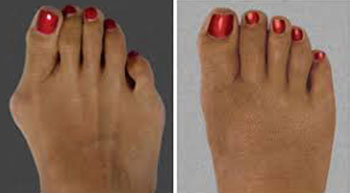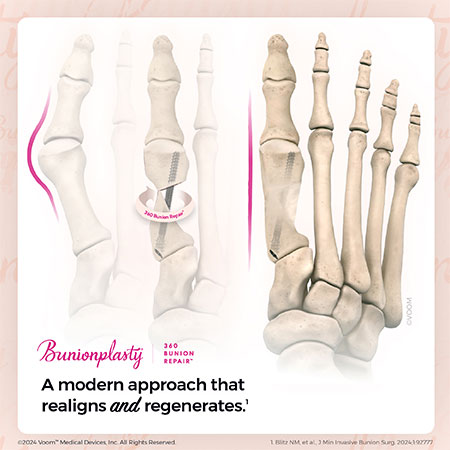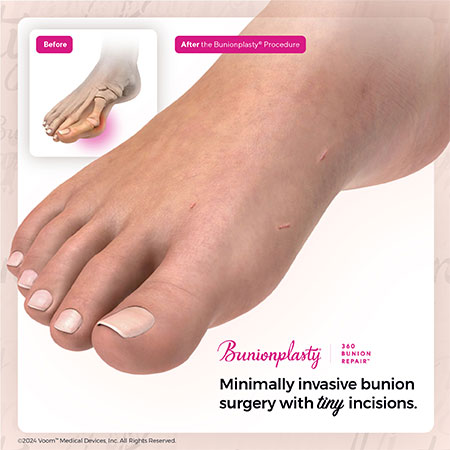Minimally Invasive Surgery

What is “Minimally Invasive Foot Surgery”?
This is a surgical technique where the operation is performed through very small incisions, only a few millimeters long. This is in contrast to traditional surgery, which is performed through large incisions on the foot.
What are the advantages?
Minimally Invasive Surgery has perceived advantages over open surgery:
- Smaller Incisions are made
- Fast healing time
- Minimal Scar
- Less swelling and discomfort
What conditions can be treated with MIS?
This technique is particularly useful in bunion surgery, where very small scars and better joint movement can be achieved. Other condition and deformities includes: Hammertoes, heel pain, metatarsalgia, neuroma, stiff big toe, diabetic foot ulcerations, and so on.
How is minimally invasive foot surgery performed?
The foot is numbed using an ankle block like traditional surgery and you can be awake or asleep, depending on your preference. A few 3mm incisions are placed around the foot to allow access for the specialized instruments. A radiologic precision diagnostic machine is integral to the operation to ensure the instruments are directed accurately, ensuring precise bony cuts and therefore an excellent correction.
Can any surgeon perform this kind of surgery?
No. Very specific training in minimally invasive techniques is required and these training courses have restricted access. A new range of surgical tools, not normally used in traditional open surgery are used and these require a new set of technical skills in order to master the different surgical techniques. This requires training and experience. Not all foot and ankle surgeons perform minimally invasive foot surgery.
Is it for me?
Most people are eligible to have minimally invasive surgery, however it is not for everyone. Some deformities are too large to be corrected using minimally invasive techniques. A consultation with us will allow you to discuss this in detail and decide which method of foot correction is appropriate for you.
Importantly, the form of Minimally Invasive Surgery (MIS) we have developed is founded on long established approaches to foot surgery. This means the patient’s recovery and outcome is very controlled and predictable. However, we are able to achieve this outcome while reducing impact on bone structure and soft tissues.

Minimally invasive surgery: Before and after.
Bunionplasty® Procedure

Bunion surgery designed with your lifestyle in mind.
The Bunionplasty® procedure is the revolutionary, minimally invasive bunion surgery (MIBS) that focuses on aesthetic results and gets you back on your feet fast. How fast? You can walk the same day as your procedure - even if you’ve had both feet fixed at once. Of course, only your doctor can make these decisions with you. Learn more about how it works, then get started today.
How is it possible?
The Bunionplasty® 360 Bunion Repair™ procedure relies on two important pillars: technology and technique.
Specialized bone screws have been developed for minimally invasive bone surgery. Notice that we didn’t say “screws and plates.” Complex hardware often isn’t necessary in next-generation bunion surgery. Your doctor can choose to perform the Bunionplasty® 360 Bunion Repair™ procedure using just a single screw, depending on your specific case.
But the technology is as successful as it is because of our patent-pending methods, which require hands-on surgical training and education. So make sure to choose a provider who’s specially trained in the Bunionplasty® procedure.
Bunions: Symptoms, causes, and treatment.

What is a bunion?
A bunion, or hallux valgus, is more than just a bony bump. It’s a medical deformity that occurs when the big toe joint rotates out of alignment. The big toe begins to “lean” toward the other toes, causing a bump at the base. Bunions can range from mild to moderate to severe, and even small bunions can cause pain and mobility problems. They can make it hard to wear your favorite shoes or participate in work, fitness, and social activities. Bunions are a multidimensional medical problem that gets worse over time, impacting every area of life.
What causes bunions?
Bunions are primarily a genetic problem, but some things can make them worse. Wearing high heels or shoes that don’t fit correctly can make an existing bunion worse by putting additional pressure on the big toe joint, contributing to inflammation, pain, and reduced mobility as the bunion progresses. Other medical issues can also make bunions worse, especially if they cause abnormal foot mechanics and uneven distribution of weight across the joints of the foot.
What are the symptoms of a bunion?
A bony bump at the base of the big toe is the first and most common sign of a bunion. The big toe may also lean toward the other toes. Symptoms can include pain, swelling, redness, and joint stiffness in the joint, and certain footwear and activities can make these symptoms worse. As the bunion grows more severe, the skin can become irritated, leading to blisters or calluses.
How are bunions diagnosed?
Your doctor will typically begin with a visual and/or physical examination, to evaluate the shape of your foot and the alignment of your big toe. They’ll ask about symptoms like pain and difficulty wearing shoes, and ask you to describe the impact your symptoms are having on your life. They may also take x-rays to confirm the diagnosis, and assess your bunion’s severity by evaluating the angle of the big toe misalignment. They may also rule out or address other conditions, like osteoarthritis.
Can bunions be prevented?
Because bunions are a genetic condition, they can’t be prevented - but you can take steps to reduce your risk of developing them, or slow their progression if you do. Wearing properly fitted, comfortable shoes with a wide toe box helps reduce pressure. Your doctor may recommend specific exercises that can stretch and strengthen the muscles around your toes. Avoiding high heels or narrow shoes may also help prevent bunions from forming or worsening, and maintaining a healthy weight range for your body can reduce additional stress on your feet.
When is surgery necessary for a bunion?
Your doctor may recommend bunion surgery if non-surgical treatments fail to relieve pain and other symptoms, or if the bunion significantly interferes with your daily activities. They may also suggest surgery if your bunion deformity gets worse over time, you’re having difficulty walking, your toes are severely misaligned, or you have other related symptoms that don’t improve with non-surgical measures.
Walk the same day, even with both feet repaired.
The Bunionplasty® 360 Bunion Repair™ procedure uses proprietary technology and techniques that stabilize the bones. It’s minimally invasive bunion surgery (MIBS) - the real deal, not just bunion surgery with smaller incisions.
That’s what makes it possible to walk immediately after surgery in just a small surgical sandal, even if you’ve had bunions corrected on both feet. Of course, it’s up to your doctor, so now is the perfect time to find out more.
Nanoplasty for Foot Care: A Revolutionary Approach
Nanoplasty is an advanced medical technique that utilizes nanotechnology to repair and regenerate tissues at a microscopic level. In foot care, nanoplasty is emerging as a potential treatment for conditions affecting the skin, joints, and connective tissues. This innovative approach involves the use of nanoparticles, which can enhance the healing process by delivering targeted treatments to damaged areas with precision.
One promising application of nanoplasty in foot health is for repairing damaged cartilage in conditions such as arthritis. By using nanoscale materials, medical professionals aim to promote cell regeneration and improve joint function. Additionally, nanoplasty may be beneficial for treating chronic wounds, such as diabetic foot ulcers, by accelerating tissue repair and reducing infection risks.
For individuals suffering from heel fissures or skin-related issues, nanotechnology-infused creams and treatments can provide deeper penetration of moisturizing and healing agents. This allows for faster recovery and improved skin integrity. While still a developing field, nanoplasty holds great potential in podiatric medicine by offering less invasive and highly effective treatment options.
As research advances, nanoplasty may become a standard approach for addressing foot pain, tissue damage, and degenerative conditions, leading to improved mobility and overall foot health for patients.




